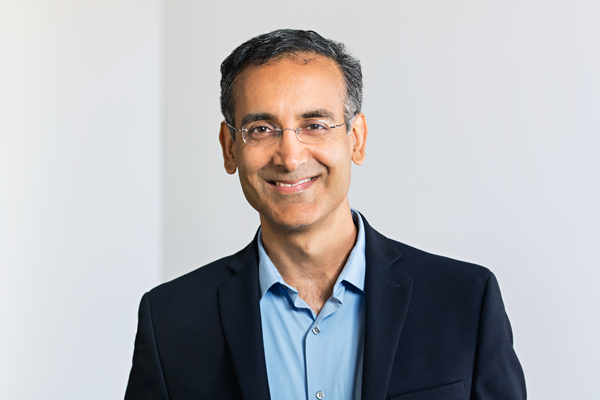If Roy Singh listed all his areas of expertise on a business card, he’d need to print in pretty small type. Over more than two decades in finance, analytics, and technology, Singh has accumulated experience in payment systems, wealth management, retail banking, credit-card fraud, portfolio analytics, and natural language processing.
Singh was an early adopter of the big data framework Apache Spark, and he even worked with the United Kingdom government at one point, “processing the whole blogosphere” for early warning signals of potentially dangerous activities as part of a national counterterrorism project. And as CTO for Guavus Inc., a leading data analytics company in the telecom space, he led a platform technology renewal that resulted in higher performance, allowing him to oversee the processing of hundreds of billions of records per day.

“We’re trying to use the data and analyze it in ways that give a lot more insight to that customer base on where investment money is going and how it is performing.”
With that in mind, Singh was perfectly suited to become CTO at financial technology product AltX. “I benefit from having worked at the cutting edge of very demanding data problems,” he says, “and understanding how you make bets on emerging technologies in the open-source space. It’s about how you build a team around those, and how you evolve along with those technologies, even as the technologies themselves are changing rapidly.”
WHAT IS AltX?
AltX is a data-
analytics platform for investment managers. It combines unique data (even including, for example,
divorce records and golf handicaps of hedge fund managers) and analytics, proprietary behavioral-finance insights and network-mapping capabilities in one aggregated platform.
The appeal of taking on familiar, passionate challenges was certainly a big draw for Singh coming to AltX. But he was also drawn by the team already in place there, and the stage of development they had reached as a business. “I think there are some industries that are easy to disrupt as an outsider,” he says. “Others require, from a business perspective, a lot of knowledge of the industry, and a lot of relationships within the sector to make the venture successful. Institutional investing, for me, is definitely in the latter category. The strength of the business team here gave me a lot of confidence in its ability to deliver the necessary knowledge and relationships.”
That team—which consists not only of technology and marketing experts but data scientists, behavioral scientists, and Wall Street professionals—launched AltX as a technology platform designed to improve the process of capital allocation between investors and hedge funds. They provide investors with a new level of unique insight regarding their alternative investing decisions, Singh notes. In general, the data sources currently being used for such tasks are fragmented and constantly changing. That’s a first-priority challenge for him, and one that AltX is addressing in a variety of ways: Internet info-gathering via crowdsourcing and crawling message boards, negotiation of licensing deals with third-party information providers (and harmonizing that data as needed), and even working with customers to allow them to integrate their own data with AltX and vice versa.
“There are big challenges here around data integration and around how to architect a system with all these multiple messy systems of data,” he says. “Once the data is cleaned up and integrated, the challenge comes in designing analytics modules to deliver something useful out of that dataset; to be able to predict the evolution of certain aspects of each individual fund, and to help the investors mold their portfolios. One side of all that sounds a lot more glamorous than the other side—but both sides excite me.”
Cleaning up data also allows the application of quantitative finance techniques, which is another area of expertise for Singh. Whether he’s analyzing the way individual securities behave at a portfolio level, or analyzing past performances of given funds and balancing it against current in-house forecasting of the same, he counts on the clearest data possible to deliver the most comprehensive financial picture to AltX’s customers.
“We’re trying to give financial institutions and institutional investors insight into trends in the alternative investments marketplace and the performance of individual funds,” he explains. “We’re trying to use the data and analyze it in ways that give a lot more insight to that customer base on where investment money is going and how it is performing.”
Scaling technology—where amounts of data take center stage—is one component of what Singh and his team do as well. Having come from a company that processed hundreds of billions of records on a daily basis, Singh is familiar enough with the concept to determine that the “sheer size” of the data in any given situation is not the main problem at AltX. “A lot of the headlines around big data have been around scaling on volume,” he says. “But I think most of the day-to-day problems people have in enterprises are on another dimension.”
It’s the school of thought acknowledging the “three Vs” of big data—volume, yes, but also velocity and variety—that Singh subscribes to with regard to scaling issues. Sometimes a fourth “V,” representing veracity, is part of that same line of thought, and Singh uses it when considering the needs of AltX. By focusing on both that veracity (truth of the data) as well as the variety (integrating different sources while taking into account their reliability), he sees AltX thriving, and thinks other businesses could benefit greatly from doing the same.
“My experience is that scaling up systems to handle massive volumes of data, for many enterprises, is not necessarily the main priority,” he says. “I think many more businesses have bigger problems with the variety and correctness of data and with timing of data flow. Fusing multiple sources of inconsistent, changing data into a foundation on which applications can be built is a big challenge.”
Photo by Robert Houser
